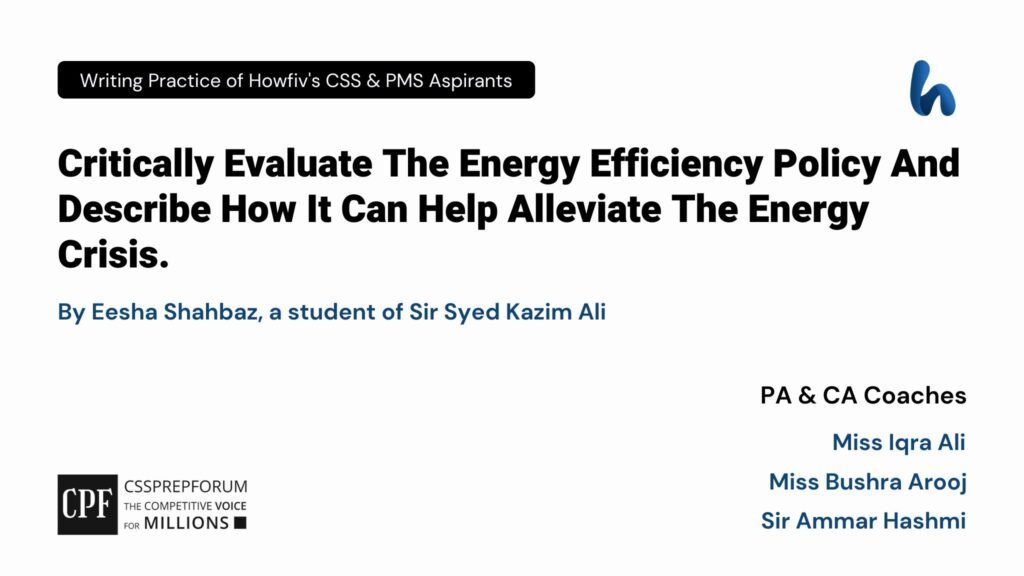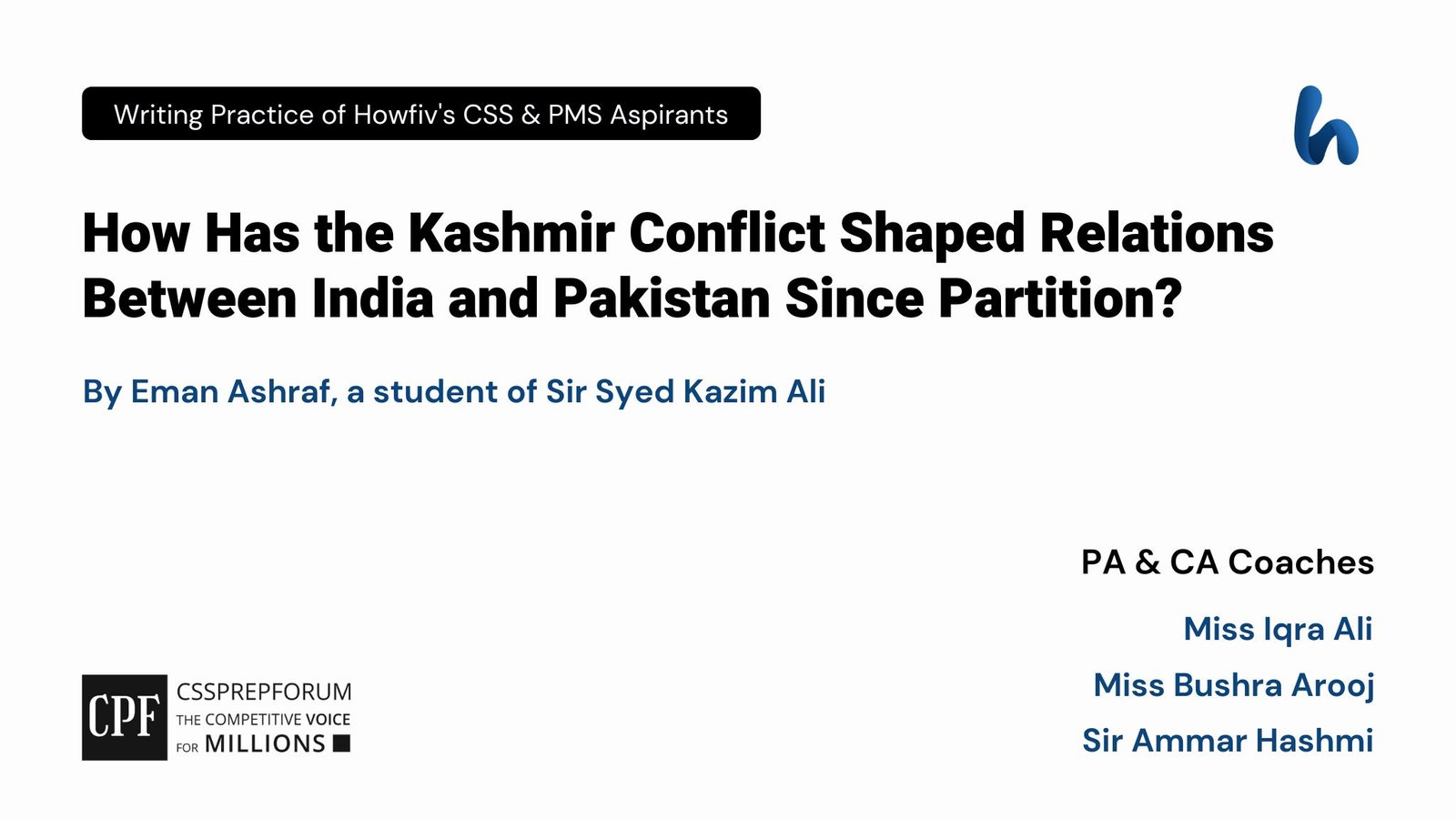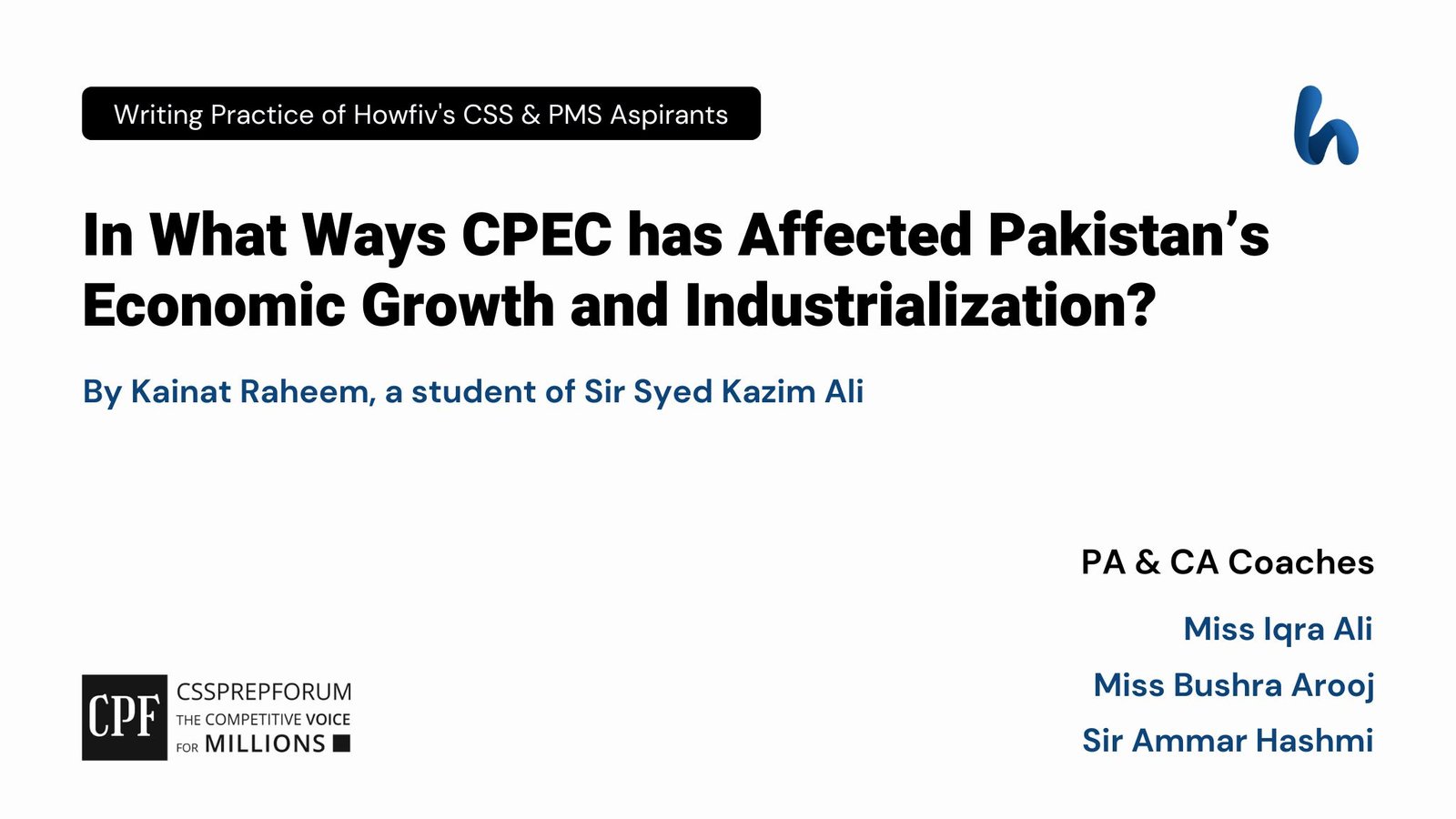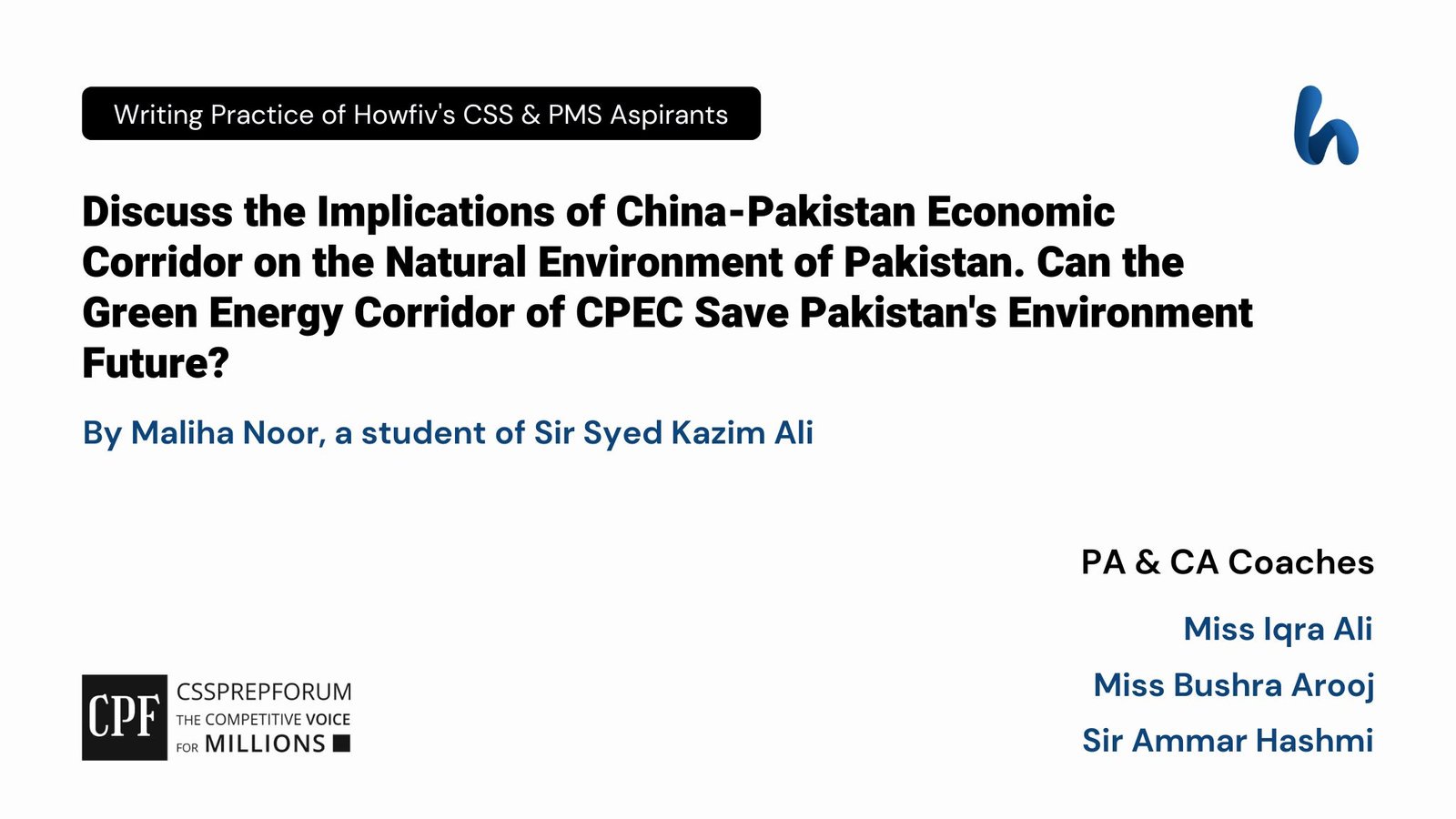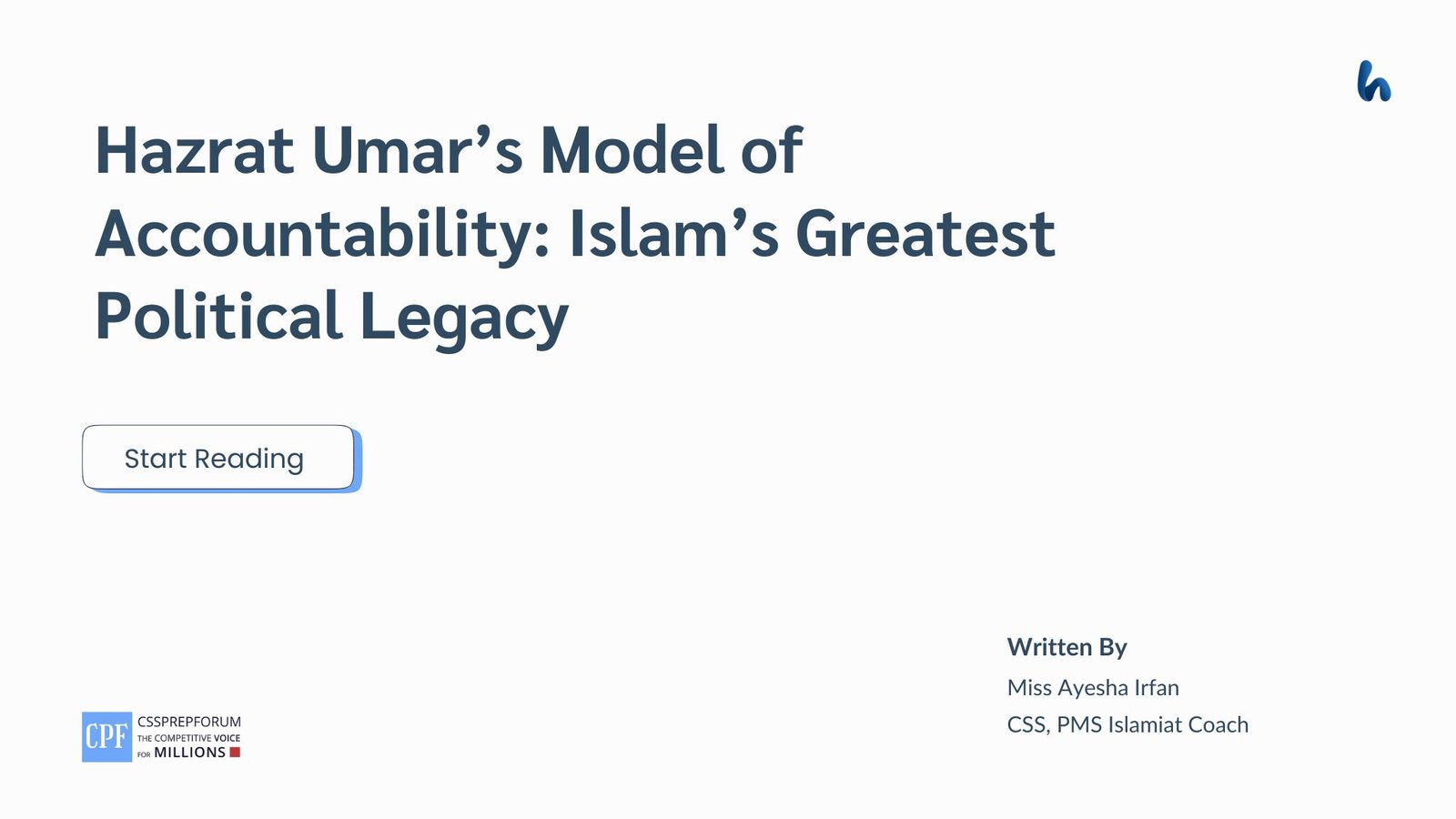CSS Current Affairs | The Energy Efficiency Policy and its Role in Energy Crisis.
The following question of CSS Current Affairs is solved by Eesha Shahbaz under the supervision of Howfiv’s Pakistan Affairs and Current Affairs Coaches. She learnt how to attempt 20 marks question and essay writing from Sir Syed Kazim Ali, Pakistan’s best CSS and PMS English essay and precis teacher with the highest success rate of his students. This solved past paper question is attempted on the pattern taught by Sir to his students, scoring the highest marks in compulsory and optional subjects for years, and uploaded to help aspirants understand how to crack a topic or question, how to write relevantly, what coherence is, and how to include and connect ideas, opinions, and suggestions to score the maximum.

Outline
1-Introduction
2-Vision behind the energy efficiency policy of Pakistan
3-A critical assessment of the national energy efficiency policy of Pakistan
- ✓Industrial sector
- ✓Transport sector
- ✓Building sector
- ✓Energy sector
- ✓Agricultural sector
4-Ways in which the national energy efficiency policy of Pakistan can alleviate the energy crisis in the country
- ✓Reduce the transmission and distribution losses by promoting upgrades in grid infrastructure
- ✓Promote renewable energy sources into national energy mix
- ✓Enhance the working of the industrial sector by taking financial incentives and energy audits
- ✓Reduce fuel imports decreasing dependency on fossil fuels and energy costs
5-Critical Analysis
6-Conclusion

Answer to the Question
Introduction
Energy Efficiency Policy of Pakistan is a great way to pave the way for sustainable development in the country. Improvement in energy efficiency and conservation is one of the easiest and least cost-effective pathways to improve the country’s energy sector sustainability. However, with every policy, the benefits are followed by some drawbacks that hinder the potential of that project – the same is the case with Pakistan’s energy efficiency policy of Pakistan which offers a plethora of benefits, followed by some loopholes. This policy offers a comprehensive overview of the country’s energy sector and possible ways to mitigate the country’s energy crisis. Amidst the rising energy prices, fluctuation in the exchange rate, increased demand for energy, and reduction in energy sources calls for immediate implementation of a national energy efficiency policy in the country. It is an important part of the sector’s planning and policy formulation; as a result, it can produce multiple benefits of industrial competitiveness, reduction in energy bills, improvement in access to energy, and achieving Nationally Determined Contributions (NDC) and sustainable development goals. This answer sheds light on the critical assessment of Pakistan’s energy efficiency policy and how it can pull the country out of the hot waters of the energy crisis.
The vision behind the energy efficiency policy of Pakistan
The current situation of the energy crisis demands a critical evaluation of the policies and how multiple measures hold the potential to mitigate the energy shortage prevailing in the country. The main purpose behind energy efficiency policy is to steer the country towards a culture of conservation and efficient use of energy resources to achieve sustainable development. According to the director of NECCA, ‘The National Energy Efficiency and Conservation Policy 2023 holds the potential to reduce Pakistan’s overall energy consumption by up to 10% by 2030, which can save approximately 5,000 MW of electricity annually.’ This highlights how the effective measures and pragmatic steps under this policy can be instrumental to achieving the desired sustainable goals. Moreover, this policy also aims to double the rate of improvement in energy efficiency, ensuring cost-effective measures and developing market-based mechanisms.
A critical assessment of the national energy efficiency policy of Pakistan
This policy encompasses five sectors that have been prioritized to achieve energy efficiency and conservation goals. The following highlights the critical overview of the policy interventions of each sector under the national energy efficiency policy of Pakistan:
- Industrial sector
Fortunately, the industry is responsible for the largest share of energy use, at 37.1 percent. This policy aims to promote energy-friendly practices in industrial production. According to this policy, the set target for saving millions of tonnes of oil equivalent is 2.3 per cent; this would result in an emission reduction of 8.97 million tonnes of Co by 2030. Measures such as conducting audits and incentives, placing energy managers, and implementing the energy management system are also needed. Moreover, there would be a ban on the manufacture, sale, and import of motors that are lower than the International Efficiency Class 2 (IE2) standard by 2027, helping reduce the energy shortage. Despite the incentives, the industrial sector is based on outdated energy machinery within small and medium enterprises (SMEs), which requires a lot of investment to upgrade. Moreover, there is a weak mechanism for the regulation of policies due to poor governance and limited capacity for monitoring. In addition, this policy also lacks focus on energy recovery. Thus, industrial sector reformation includes working on the above-mentioned key areas to maximize the chances of success in such policies.
- Transport sector
The second most important sector that comes under Pakistan’s national efficient energy policy is the transport sector, which requires a framework and strict checks to maximize the benefits it holds. The transportation sector consumes about 30.3 per cent of the total fine energy consumption as it is heavily dependent on fuel. According to the recent report of NECCA, the number of cars and motorcycles has been growing at 10 per cent annually, and subsequently, there is a rise in demand for fuel. Under this policy, the benefits can be introduced through electrification of existing transports and new electric vehicles and mandatory yearly energy audits of public sector transport fleets by 2023. However, this shift to new electric vehicles is slow as there is a high upfront cost, making it challenging for the common masses to adopt. Moreover, the public transport system of Pakistan is underdeveloped and fragmented, which also serves as a challenge in itself in reducing the policy impact. Hence, the policy measures for the transport sector within this policy require a proper framework and robust check to ensure its efficacy for the desired purpose.
- Building sector
The third most important sector is the building sector, which includes commercial, residential, public, and private buildings, which require initiatives and energy-efficient designs. There is a high demand for new construction, 5.3 percent of the year, due to rising population and urbanization. According to the NECCA report, over 40 million people are expected to live in urban centres and towns, which implies that many buildings will be under construction or are being planned. This highlights how the demand is rising, maximizing energy consumption in the medium and long run. The policy sets the target of saving 2.2 million tonnes of energy in the building sector, resulting in an emission reduction of 8.29 million tonnes through sectoral measures. However, there are inadequate financial incentives for builders to invest in energy-saving construction practices. Moreover, the enforcement of buildings is not uniform across different regions, especially rural areas. Therefore, the industrial sector is another important factor that can play a key role in energy conservation by adopting different measures.
- Energy sector
Another important thing underlined in this policy is the energy policy, which also includes significant measures to enhance the energy sector and address pressing challenges. This policy is comprehensive as it includes the establishment of energy efficiency and conservation cells in DISCOs and implements demand-side management programs. Such measures can improve the performance of the system, facilitate energy use, and develop capacity. NECCA aims to save 1.05 million tonnes and reduce 6.01 million tonnes of energy by 2030. However, there are many weaknesses that hinder the potential of such policies. This highlights that there are high distribution losses of about 20-30% in some DISCOs. Moreover, there is also increasing dependence on inefficient power plants, limiting the operational efficacy. Thus, energy policy is another important factor that can bring a plethora of benefits if addressed properly.
- Agricultural sector
Lastly, agriculture is another main part that contributes about 1.5 percent of total final energy consumption. With the advancement, commercial energy is being used for agricultural productivity, including irrigation through diesel. According to NECCA, this policy aims to save 0.64 million tonnes of energy; thus, it results in an emission reduction of 2.82 million tonnes of carbon dioxide by 2030. However, there is no focus on using energy use in storage facilities and agricultural processing that can reduce energy consumption in the agriculture sector. Moreover, the adoption is limited as this shift requires high costs, and limited financing is offered to farmers. The poor infrastructure of rural areas also hinders the progress of such policies. Thus, agriculture is another important sector that poses benefits and challenges to policy implementation effectively.
Ways in which the national energy efficiency policy of Pakistan can alleviate the energy crisis in the country
The following are the ways in which Pakistan’s national energy efficiency policy can help mitigate the country’s energy crisis.
- Reduce the transmission and distribution losses by promoting upgrades in grid infrastructure.
Transmission and distribution losses are critical issues that demand immediate attention from the government. This policy aims to mitigate these losses by upgrading the grid infrastructure, such as using aluminium and copper conductors. Smart grid technologies like high-voltage direct current (HVDC) cables and aerial bundled cables can be used to produce long transmission lines. This would help reduce the losses and ensure that energy reaches the maximum people without getting wasted in the process. Moreover, introducing automated grid management can also help reduce power theft and technical issues in the energy sector. Thus, controlling the losses incurred by distribution and transmission lines can help mitigate the country’s energy demands.
- Promote renewable energy sources into the national energy mi.x
The promotion of renewable energy sources is another possible solution. Pakistan’s energy sector is heavily dependent on imported thermal fuel to meet its energy needs. This policy would help shift to renewable energy sources, such as solar energy, wind, and hydropower, into the national mix. This shift can also provide a long-term solution to meet growing energy needs and provide a stable pathway to diversity in the energy supply.
- Enhance the working of the industrial sector by taking financial incentives and energy audits.
The industrial sector plays a key role in enhancing the energy sector in the country; thus, reviving energy policies concerning the industrial sector is beneficial. Such policies can help boost production by focusing on energy audits and taking financial incentives. For instance, this policy can help lower the consumption of energy by freeing up the power of other sectors. Moreover, financial energy policies provide incentives for industries to adopt energy-efficient technologies; consequently, they boost energy savings and overall productivity by consuming less power.
- Reduce fuel imports, decreasing dependency on fossil fuels and energy costs.
It is important for Pakistan to shift to renewable energy sources so there is less dependence on fossil fuels, ultimately reducing energy costs. The country’s energy is more dependent on oil and gas, which is imported at high cost. It is important to reduce the economic strain as the prices change in the wake of global oil markets. Resultantly, this would reduce the billing cost for consumers and operational costs for businesses. Thus, promoting renewable energy sources can help reduce the reliance on fossil fuels and high energy costs.
Critical Analysis
The energy sector of Pakistan is in dire need of reforms as the supply of energy is insufficient to meet the growing energy needs of people. Its multi-sectoral approach, targeting the industrial, transport, building, energy, and agricultural sectors, showcases a strong commitment to reducing energy wastage and enhancing efficiency. However, there are some loopholes that need to be addressed so that we can gain maximum benefits from such policies and leverage their potential. Addressing the prevailing challenges and implementing the national efficient energy policy carefully can help alleviate the energy crisis in the country.
Conclusion
Policies like the national energy efficiency and conservation policy of Pakistan hold a strong potential to mitigate the problems existing in the energy sector of the country and promote sustainability. It is a comprehensive policy encompassing different sectors, such as industrial, building, energy, and agricultural sectors. While it holds the potential to transform the energy sector of the country, it also provides some challenges that need to be addressed. Addressing the challenges would thereby maximize the potential of such policy and mitigate the country’s energy crisis.

CSS Solved Past Papers’ Essays
Looking for the last ten years of CSS and PMS Solved Essays and want to know how Sir Kazim’s students write and score the highest marks in the essays’ papers? Then, click on the CSS Solved Essays to start reading them.
CSS Solved Essays
CSS Solved Islamiyat Past Papers
Want to read the last ten years’ Islamiyat Solved Past Papers to learn how to attempt them and to score high? Let’s click on the link below to read them all freely. All past papers have been solved by Pakistan’s top CSS Islamiyat coach having the highest score of their students.
CSS Solved Islamiyat
CSS Solved General Science & Ability Past Papers
Want to read the last ten years’ General Science & Ability Solved Past Papers to learn how to attempt them and to score high? Let’s click on the link below to read them all freely. All past papers have been solved by Pakistan’s top CSS GSA coach having the highest score of their students.
CSS Solved General Science & Ability

